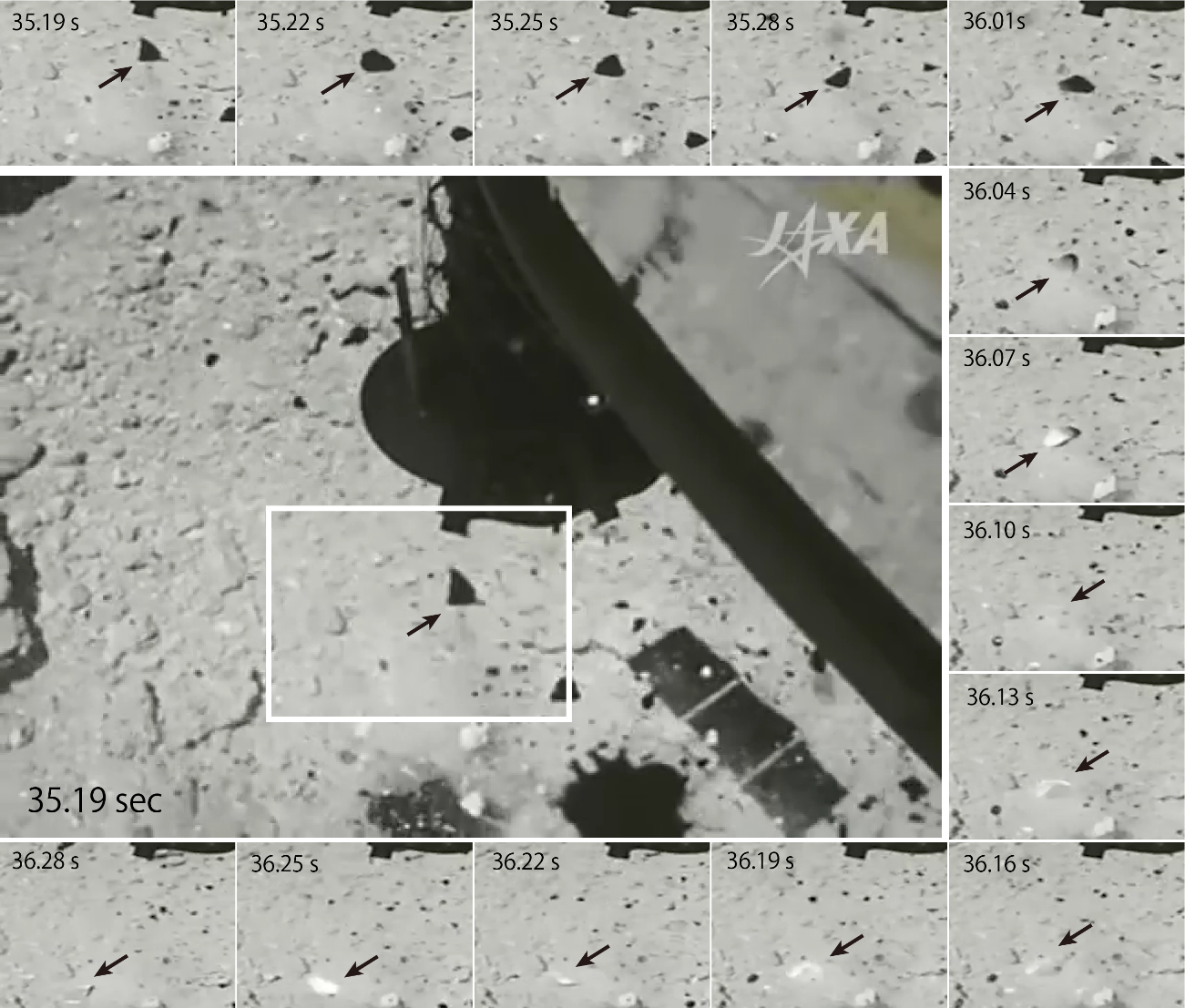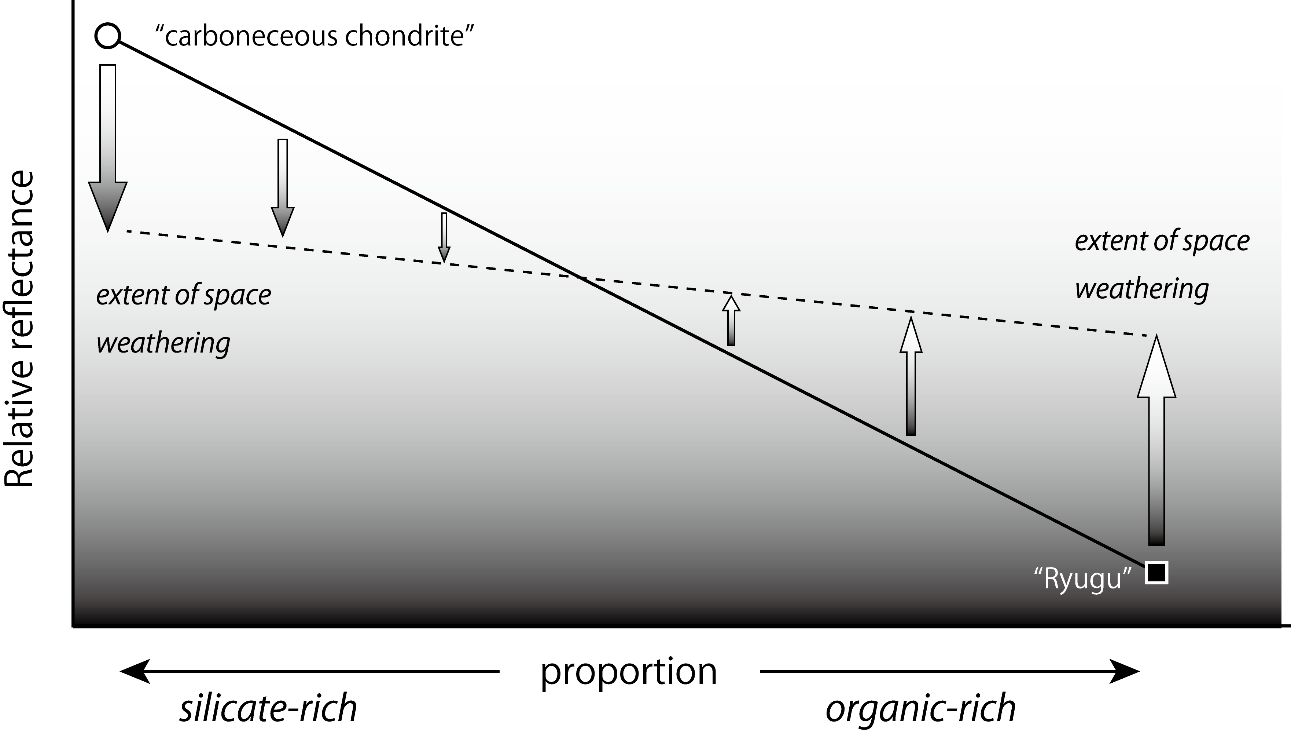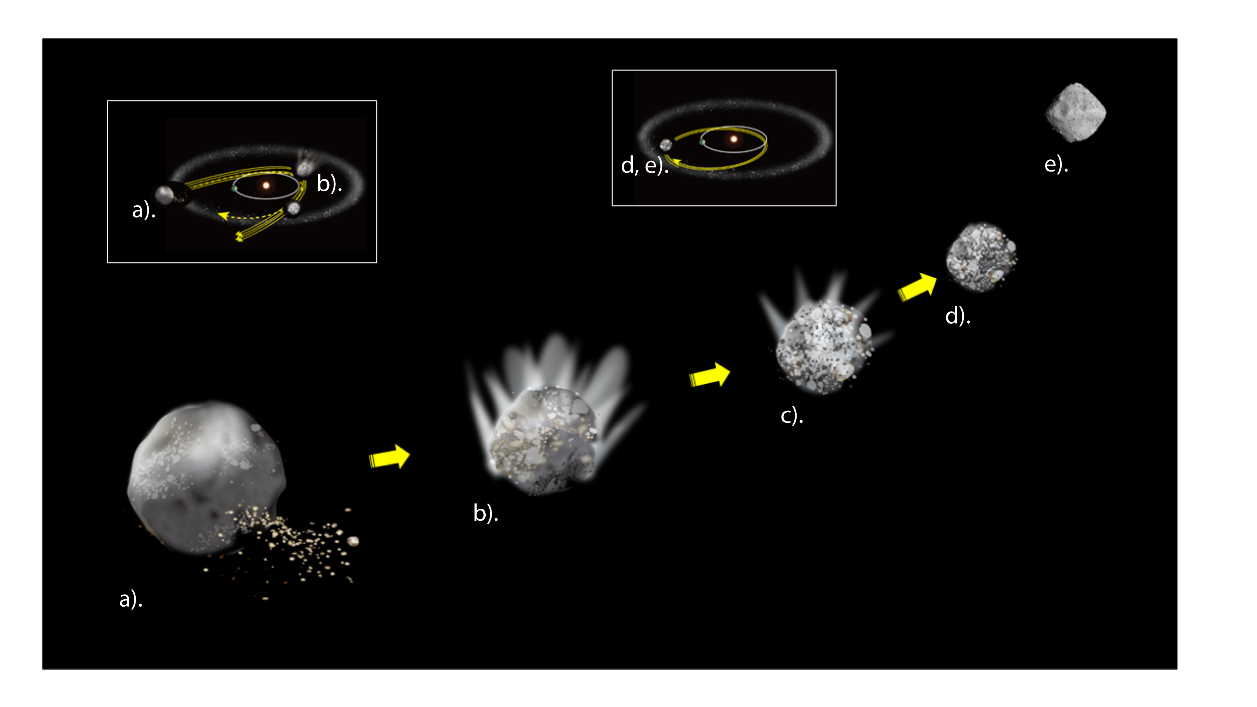Evidence for a large organic abundance in the asteroid Ryugu. — A large abundance of organic matter was inferred from displaced material captured by the Hayabusa2 touchdown video.
Key Points
- Calculations indicate that the surface of Ryugu could contain ~60% organic matter.
- Ryugu may have formed through the capture of rocky fragments by an icy comet, which were shaken to the core. Subsequently, the ice sublimed exposing the rocky core and forming the abacus bead shape of Ryugu.
- We will apply a comprehensive analytical system to the samples brought back by the Hayabusa2 spacecraft in the end of 2020 and thus verify the evolution model for the formation of organic-inorganic solar system bodies such as Ryugu.
Overview
Eizo Nakamura, who leads the Pheasant Memorial Laboratory, Institute for Planetary Materials, Okayama University at Misasa, first noticed that fragments displaced by the Hayabusa2 space craft had sides which displayed different shades (albedo). A phenomenon known as space weathering can change the physical properties of materials and thus their colour. On examination of spectral data and after several calculations, it was found that a high organic content (~60%) could account for the colour change. From previous investigations using telescopes, Ryugu was thought to be similar to a class of meteorites called carbonaceous chondrites. However, in light of the high organic abundance, Ryugu may in fact be the remnants of a comet, which lost its ice through sublimation as it transited into and out of the solar system. As a comet passes through the solar system it experiences impacts, gravitational interactions and heats up and cools down, all of which can cause vibrations that may shake rocky material to its core. On the loss of ice, organic material could have become concentrated at the surface of Ryugu, whilst the speed at which the body spins would increase, leading to its abacus bead shape.
The aforementioned Misasa model for Ryugu will be verified by analysing the samples to be returned by the Hayabusa2 spacecraft in the end of this year. A collaboration agreement has been signed between JAXA and the Okayama Institute for Planetary Materials, with the Pheasant Memorial Laboratory designated as a phase 2 curation facility. If our model is correct, the analysis of Ryugu samples will significantly shift our conventional interpretation of the formation of rocky bodies within our solar system.
The results of our study were published in the scientific journal Astrobiology published on June 15, 2020.

Background
Asteroids represent material which formed shortly after the formation of the solar system, some 4.6 billion years ago, but are also thought to record subsequent solar system processes. Leading on from the success of the Hayabusa mission, the first to explore an asteroid (Itokawa), Japan launched the Hayabusa2 mission to explore Ryugu and return organic bearing material. At present the Hayabusa2 spacecraft has completed its mission and is on course to arrive at Earth in the end of 2020.
Humanity cannot elucidate, with scientific reasoning, materials from space using remote sensing or theory alone. Collecting samples from a location and returning them to Earth for detailed analysis is essential, as it is impossible to equip a spacecraft with the entire suit of analytical instruments available on Earth. In order to obtain significant results from the Hayabusa2 samples, it is necessary to make predictions about their nature and composition. Such predictions are paramount to the successful preparation of analytical procedures.
Research Methods
On February 22, 2019, Hayabusa2 successfully touched down to collect samples. The footage taken by the on board camera during the touchdown is extremely interesting (https://youtu.be/-3hO58HFa1M).
On touching down, Hayabusa2 fired a projectile inside the sampler horn, causing it to make contact with the surface of Ryugu and push surface debris into its opening. Subsequently, the spacecraft fired its thrusters to ascend back into orbit. Surface debris was lifted up and scattered during the assent and the rotation of fragments was caught by the Hayabusa2 on board camera. The rotating fragments had a lighter and darker side (Figure 1). The surface of Ryugu matches the lighter colour and thus the darker colour is thought to resemble material from beneath the surface. In order to explain the change in colour, calculations utilising spectral data from irradiation experiments (simulations of space weathering) were performed and the composition of the surface material was evaluated.
Research Results
Asteroid surfaces are exposed to high energy particles, such as those of the solar wind. Spectroscopic studies have suggested that Ryugu is of a carbonaceous chondrite composition, which would consist of <10% organic matter (normally around 3 weight%) and >90% silicate minerals. Irradiation studies have shown that silicate minerals become darker on exposure to solar wind, through the formation of nanometre sized iron particles, which adsorb the visible light that hits their surface.
However, the footage from the Hayabusa2 camera indicates that the surface of Ryugu is lighter than the interior, this suggests that the original material became lighter on exposure to space. Previous experiments have simulated the interaction of organic matter with irradiation, such as that caused by hydrogen and helium ions from the solar wind. On exposure to significant irradiation organic matter is converted to graphite, which reflects visible light to a much greater extent than organic matter. Therefore, space weathering of organic matter can explain the lighter surface colour of Ryugu compared to its interior (Figure 2).
To ascertain what proportion of organic matter would be required, mass balance calculations were performed and yielded a value of ~60%. The organic content reported here is significantly different to that previously assumed based on carbonaceous chondrites. Once the samples of Ryugu are delivered to Earth the organic content can be determined and our model evaluated.

The formation of an organic rich Ryugu, is supported by the model proposed for the Chelyabinsk meteorite parent body(Nakamura et al., 2019). In the Chelyabinsk model, an ice rich comet captures rocky debris. Subsequently, fluid phases beneath the surface of the ice may form as the comet passes close to the sun. The fluids likely led to the altered minerals and veins found within the Chelyabinsk meteorite. In the case of Ryugu the fluid phases may allow the migration, polymerisation and eventual concentration of organic material at the surface of the body after the cometary ice has completely sublimated.
Additionally, the captured silicates could be moved to the core of the comet, through vibrations induced by collisions, gravitational interactions with other bodies and expansion and contraction of the body as it passes through the solar system. As the ice is sublimed, the main mass of the body (the silicate fragments) is conserved, but the bodies diameter decreases. In order to conserve the angular momentum of the spinning body, the spin velocity of the body must increase. As the spin velocity increases, so does the centrifugal force, which stretches out the equator of the body and this results in the abacus bead or spinning top shape of Ryugu.

Future Work
Scientific predictions concerning the asteroid Ryugu can be verified by direct analysis of the Hayabusa2 samples in laboratories on Earth. The Pheasant Memorial Laboratory, Institute for Planetary Materials, has a track record of analysing small quantities of extraterrestrial materials (Nakamura et al., 2003). The Laboratory developed a new analytical methodology called the comprehensive analytical system for terrestrial and extraterrestrial materials (CASTEM). An initial comprehensive analysis of 5 particles from Itokawa, returned by the Hayabusa spacecraft, were performed, which was the first time an asteroid had been directly analysed on Earth (Nakamura et al., 2012). Based on the aforementioned experience, a new analytical system has been developed to incorporate the analysis of organic matter (CASTEM plus).
For Hayabusa2 samples a higher level of curation will be conducted using the CASTEM plus in order to facilitate organic matter analysis. It is essential to analyse Hayabusa2 samples to evaluate the predictions made about Ryugu, using remote sensing and theoretical modelling.
The analysis of Hayabusa2 return samples will not be limited to conventional research methods and concepts, which have been developed for meteorites. Instead the approach will be more universal in terms of materials science. We expect to make discoveries that are currently unimaginable and experience a paradigm shift in solar system science.
Utilising organic rich asteroidal materials for the first time, we will be able to challenge the current theories of solar system science. To further advance our scientific knowledge of the solar system is the most important part of the sample return mission.
Bibliography
- Eizo Nakamura, Tak Kunihiro, Tsutomu Ota, Chie Sakaguchi, Ryoji Tanaka, Hiroshi Kitagawa, Katsura Kobayashi, Masahiro Yamanaka, Yuri Shimaki, Gray E. Bebout, Hitoshi Miura, Tetsuo Yamamoto, Vladimir Malkovets, Victor Grokhovsky, Olga Koroleva, Konstantin Litasov. Hypervelocity collision and water-rock interaction in space preserved in the Chelyabinsk ordinary chondrite, Proceedings of the Japan Academy, Series B, 95(4), 165-177 (2019). doi:10.2183/pjab.95.013, dream/20190115102242-432018.
- Eizo Nakamura, Akio Makishima, Takuya Moriguti, Katsura Kobayashi, Ryoji Tanaka, Tak Kunihiro, Tatsuki Tsujimori, Chie Sakaguchi, Hiroshi Kitagawa, Tsutomu Ota, Yusuke Yachi, Toru Yada, Masanao Abe, Akio Fujimura, Munetaka Ueno, Toshifumi Mukai, Makoto Yoshikawa, Jun’ichiro Kawaguchi. Space environment of an asteroid preserved on micrograins returned by the Hayabusa spacecraft, Proceedings of the National Academy of Sciences of the United States of America, 109(11), E624-E629 (2012). doi:10.1073/pnas.1116236109, dream/20120224095412-627-620.
- Eizo Nakamura, Akio Makishima, Takuya Moriguti, Katsura Kobayashi, Chie Sakaguchi, Tetsuya Yokoyama, Ryoji Tanaka, Takeshi Kuritani, Hiroyuki Takei. Comprehensive geochemical analyses of small amounts (< 100mg) of extraterrestrial samples for the analytical competition related to the sample return mission MUSES-C, The Institute of Space and Astronautical Science Report SP, 16, 49-101 (2003). doi:a-is/3742/1/SA0200006, dream/20110602093007-717-706.
- The Chelyabinsk meteorite -- a commentary article by author
- Particles on Itokawa collectd by Hayabusa -- a commentary article by author
Manuscript Details
- Title: The Albedo of Ryugu: Evidence for a High Organic Abundance, as Inferred from the Hayabusa2 Touchdown Maneuver.
- Authors: Christian Potiszil1, Ryoji Tanaka1, Katsura Kobayashi1, Tak Kunihiro1, Eizo Nakamura1 (1The Pheasant Memorial Laboratory, Institute for Planetary Materials, Okayama University)
- Journal Name: Astrobiology
- doi: 10.1089/ast.2019.2198
- Available online at June 15, 2020.